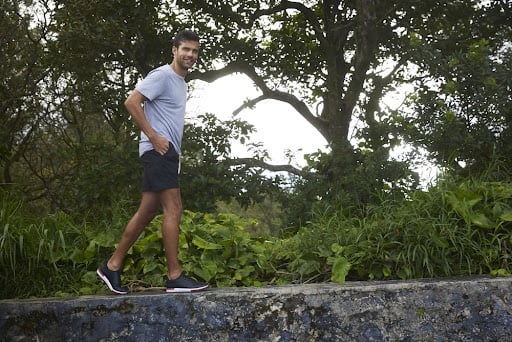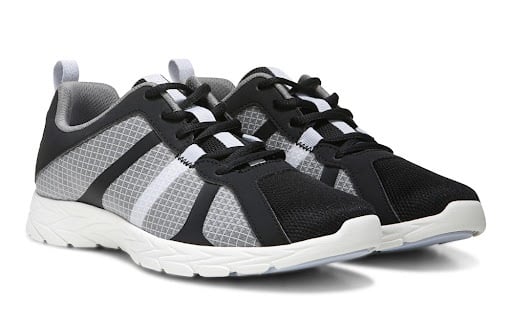In years past, many people relied on the same pair of shoes to perform just about any athletic activity. Running or working out? Same shoe. Tennis or basketball? Again, same shoe.
But these days, there’s a shoe specifically designed for almost every kind of sport or activity.1
So, if you’ve been looking to find more stability on your morning runs or even gain a little advantage on the court, check out these 7 different types of performance shoes.
1. Walking Shoes
Walking is something many of us do regularly, so you may not think you need a specific kind of shoe for it. However, choosing the right type of walking shoe can have a significant impact on your short- and long-term comfort.
When it comes to the best shoes for walking shoes for men or walking shoes for women, look for a pair that:
- Are relatively lightweight – Lightweight shoes are generally more breathable and will keep your feet comfy over long distances.
- Have enough cushion for optimal shock absorption – By having a little extra cushion, you can prevent tenderness and pain on the bottom of your foot.
- Feature a rounded sole – A bit of a rounded sole will help you comfortably shift your weight with each step.
2. Running Shoes
Regardless of whether you’re headed out to train for your next 5k or for a light jog around the neighborhood, every step you take when you run adds pressure to your ankles, knees, and hips.
However, a proper pair of running shoes can help absorb the shock of each step, protecting your joints and preventing issues like:
- Tendinitis
- Shin splints
- Stress fractures
3. Cross Trainers
If you’re regularly active in more ways than one (i.e., your daily routine includes walking, hiking, playing tennis, or generally being sporty), cross-trainers are the performance shoe your feet need. This is because cross trainers can provide extra stability across multiple motions.
Walking, exercising, or moving side-to-side all require a varying range of support. With cross trainers, that’s not a problem!
You can think of cross-trainers like the Swiss army knife of performance shoes—they provide you with what you need, no matter what type of activity you get into.
4. Minimalist Shoes
Minimalist shoes conform to your foot, almost as if you’re wearing socks instead of shoes. They mimic the feel of being barefoot but add some extra protection.
Why would any athlete want to feel like they’re performing barefoot?
Interestingly enough, some studies have shown that working out barefoot may offer a few benefits.2 These benefits can include:
- Greater awareness of any imbalances you might have
- The ability to build stronger and more flexible feet
- An increased awareness of proprioception (i.e., how aware you are of your body)
- Better stability, posture, and balance
However, it’s worth noting that some people have different foot structures than others. To ensure your safety and comfort, it may be best to speak to a medical professional about your unique performance needs to determine if a minimalist shoe is right for you.
5. Trail Running Shoes
There is a minor debate in the sneaker community regarding running shoes vs training shoes. For those who want to experience the benefits of both, you might want to consider trail running shoes. For some people, running on a treadmill at the gym, or even along a neighborhood sidewalk, can become a little boring after a while. Trail running allows runners to mix things up, providing a change of scenery and the added challenge of varying terrains and inclines.
However, if you’re going to give trail running a try, you’re going to want to wear a trail running shoe that protects against elements like water, dirt, and mud. Trail running shoes are designed with heavier, more durable materials to withstand these elements.
They also typically offer more support than the average running shoe to account for running on uneven surfaces.
6. Tennis Shoes
Tennis requires quick and jarring movements from front to back and side to side. Wearing a pair of tennis shoes will give you more flexibility, as well as support to absorb these shocks properly.
Depending on the type of court you’re playing on (for instance, hard court, clay court, or grass court), you can also find variations on the tennis shoe designed to provide:
- More or less grip
- More support under the ball of your foot
7. Other Sport Shoes
Some types of performance shoes are specifically designed for certain sports. For instance, some shoes feature a high top for additional ankle support (this is often seen on basketball shoes), while others feature cleats (usually for grass- or turf-based sports).
So, it’s important to wear the right performance shoe if you’re playing any of the following sports:
- Soccer
- Football
- Golf
- Basketball
- Baseball or softball
What Exactly is a Performance Shoe?
Put simply, a performance shoe is any shoe designed to improve your athletic performance while playing a specific sport or doing a certain activity.3
This is why you don’t see golfers wearing soccer shoes or lacrosse players wearing basketball shoes. Each unique performance shoe offers varying levels of stability, cushioning, and even arch support that meet the activity or sport’s specific demands.
Performance shoes generally differ across three different areas: their design, function, and features:
- Design – Each performance shoe is going to be designed to work best with its specific activity. For example, performance running shoes are designed to be lightweight and more responsive, whereas something like a basketball shoe is designed with stability and ankle support in mind.
- Function – The function relates to the actual results you might want to get out of your performance shoe. Think of a cross-trainer, for instance. They’re designed to withstand multiple ranges of movement and protect against the shock that can come from various exercises.
- Features – Not all performance shoes are made the same, so people will typically look for the pair that best suits their needs. For example, someone who has feet that are overpronated may look for different features than someone who has feet with flat or high arches. In any situation, you can often find performance shoes with features that can accommodate and balance out such issues.
Some shoemakers create performance shoes with enhanced functionality, but that can be a little vague, so make sure what the additional features are.
What Should You Look for When Purchasing a Performance Shoe?
What you need from a performance shoe is going to depend on a few different things. As mentioned above, the sport or activity will come into play, as well as your personal needs.
Some specifics you may want to consider before you begin your search are:
- Your weight
- Your foot type
- Your personal preferences (or even your fitness goal)
- The surface you’ll be wearing them on
- Any unique biometrics
Once you’ve determined your personal requirements, you can better determine how each of the following shoe features might benefit your unique performance needs:
- Weight – Are you going to benefit most from a lightweight shoe or one that’s a little heavier? Lightweight performance shoes can provide for a more dynamic and natural foot motion, while heavier shoes can be good for absorbing force and providing extra balance.
- Stability – A performance shoe that offers sufficient stability will often have a good level of midsole cushioning and extra support. They can help in the prevention of issues like pronation, as well as provide additional arch and ankle support.
- Motion – Consider what type of motion you’ll primarily be doing. Straight and forward, as with running? Side-to-side and up and down, as with cross-training? Performance shoes with motion control will often be more rigid than others and have a wider sole.
- Cushion – Depending on your specific activity or sport, shock absorption and dispersion can be critical. So, you may want a shoe that offers additional cushioning in various areas, like the midsole and outsole.
What Are the Benefits of Wearing Performance Footwear?
Finding and wearing the proper footwear for your own personal needs, as well as for the activity or sport you’re playing, is important.
Just consider a few of the main benefits you can experience from wearing the right performance shoes:
- Injury prevention
- Reduction in joint pain
- Arch support
- Impact cushioning and absorption
- Reduction of stress on heels, ankles, and toes
Regardless of what type of athlete you are or what activity you do most, these benefits aren’t something to take lightly. That’s because these benefits aren’t just important for short-term performance. Wearing the proper performance shoes and preventing injury and joint pain means you’ll be able to continue walking, running, or jogging (without over-taxing your body) for years to come.
Find Peak Performance Shoes with Vionic
Whether you’re an enjoy a walk through a nature trail, partake in exercise classes, or are an everyday tennis player, Vionic has a performance shoe for you. Plus, all of our shoes and insoles consider arch support, stability, and cushioning, so you can easily find a shoe that best suits your unique needs.
But performance, arch support, stability, and cushioning aren’t all we have to offer. Our performance shoes also factor in style. So, not only will you get the support you need for whatever activity you’re doing, but you’ll also look good doing it.
From tennis shoes for men to women’s athletic shoes, hop Vionic today to find men’s and women’s performance shoes for all your future activities.
Reviewed by:
Dr. Jacqueline Sutera is a surgically trained doctor of podiatric medicine specializing in the prevention and treatment of foot pathology. She graduated from Fordham University with a Bachelor of Science degree in Biology and Philosophy. She later attended the New York College of Podiatric Medicine where she earned the degree of Doctor of Podiatric Medicine (DPM).
Dr. Sutera received her postgraduate residency training at the busy level-one trauma center at Jamaica Hospital in Queens, NY and Brookdale Hospital in Brooklyn, NY. During her time there, she served as chief surgical resident and received and completed training in all aspects of podiatric medicine and surgery. Dr. Sutera is Board Certified in Foot Surgery and is a Fellow of the American College of Foot & Ankle Surgeons.
She is also a proud member and spokesperson for the American Podiatric Medical Association and the New York State Podiatric Medical Society. As one of NYC’s premier podiatric physicians, she is a caring, conscientious and extremely personable doctor who prides herself on being holistic in her approach to foot care. Where other doctors treat feet only locally, she has a unique gift of being able to link some foot problems to other underlying conditions taking place in the body.
Sources:
- “What Are the Different Types of Athletic Shoes?” WebMD. 6 March, 2022. https://www.webmd.com/fitness-exercise/ss/slideshow-different-types-athletic-shoes
- Creveling, Mallorie. “Why You Should Consider Training Barefoot.” Shape. https://www.shape.com/fitness/tips/benefits-barefoot-training
- Bell, Jessica. “How to Keep From Getting Blisters While Playing Soccer.” SportsRec. 5 December, 2018. https://www.sportsrec.com/8291434/how-to-keep-from-getting-blisters-while-playing-soccer
- Herren, Lori. “The importance of good running shoes for the runner.” Brilliant Oral Care. 23 October, 2020. https://www.brilliantoralcare.com/blogs/brilliant-choices/the-importance-of-good-running-shoes-for-the-runner




Leave a Reply